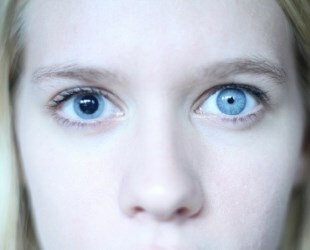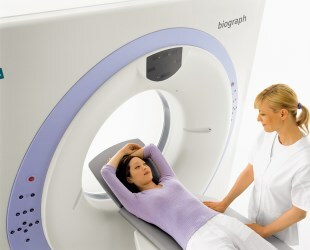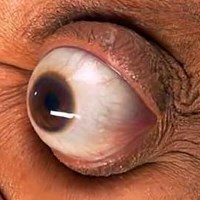
An anisocoria in the medical language is a condition in which there is a difference in the size of the pupils, but a pupillary deformation is also possible. With different lighting, the pupil of one eye behaves adequately - narrows and expands, and the other pupil remains the same fixed size.
Children who at birth had different pupil sizes, often do not have pathologies.
And if a family member has a different size of pupils, then there is absolutely nothing to worry about, the difference in the size of the pupils, most likely, is genetic.
- 1. Causes of
- 2. Diagnosis of
- 3. Treatment of anisocoria
Uneven pupil size with a discrepancy of more than 1 mm, and even more so in the case of progression of this phenomenon, often indicates a disease of the brain, nerves orblood vessels.
The word "anisocoria" of Greek origin. The size inequality is associated with an imbalance in the operation of the eye muscles, which are responsible for the dilatation of the pupil( mydriasis) and its narrowing( miosis).
Causes of
The causes of anisocoria are conventionally divided according to three criteria:
- Anisocoria can be acquired( traumatized) and congenital( often - heredity).
- Relative to the eye, the disease is divided into the eye and eye.
- One-sided and bilateral form of the disease.
This disease may be a sign of the development of some diseases, but a small difference of up to 1 mm in pupil sizes is the norm. At present, the reasons for the difference in pupil size are still unclear.

Read on - eye clinics in Samara. Where to treat eye diseases?
In the article( here) prices in the ophthalmic clinic Excimer.
Reasons for Keratoconus!http: //moezrenie.com/bolezni/ zabolevaniya-rogovitsy / stadii-keratokonusa.html
This pathology usually occurs when:
- eye injuries,
- damage to the eye muscles, as well as parasympathetic fibers that innervate the muscle or narrow the pupil,
- motor eye nerve damage,
- aneurysm,
- abscessor brain tumor,
- encephalitis, meningitis,
- disorders of various cerebral circulation plan,
- when using narcotic drugs( amphetamine, tropicamide, ecstasy, cocaine), etc.
In case of anisocoria enhancement in the lightwe can say about the parasympathetic excitation of the eyes, which is manifested in the dilatation of the pupil and in the reduction of reactions. Most cases of the development of anisocoria signal the damage to the oculomotor nerve, while causing doubling, restriction in the movement of the nerve, and often - strabismus.

If you see any abnormalities in vision, you should consult your doctor as soon as possible, because as with different pupils,
- can be seen: ambient vision,
- hypersensitivity to light,
- headache,
- vomiting, nausea,
- fever,
- sensation of severe pain in the eye.
Eidi's syndrome
With the development of the syndrome of Adi, which is characterized by neuronal damage, it is usually combined with impaired vision.
Horner's syndrome
If the symptoms of the disease increase when the source is removed and in a dark space, this is most likely due to Horner's syndrome( simple anisocoria).
This syndrome is caused by damage to the trunk of the spinal cord or its cervical region, which is accompanied by pain and weight loss of the muscles of the hand.
Argylle Robertson Syndrome
In this syndrome, in addition to the irregular shape of the pupils( for example, the shape of a pear and oval is often encountered).This syndrome manifests the unevenness of the edges of the pupils, the reaction to light is lost.
Diagnostics
Diagnosis of this disease begins with a study of the history of the onset of the disease, and also with the study of neurological and physical examinations.
Diagnostic tests that are usually performed for this disease include:
- spinal fluid examinations,
- blood tests,
- MRI,
- computed tomography,
- x-ray of the neck and skull,
- tonometry( if there is a suspicion of glaucoma).

An examination of patients with suspected anisocoria is performed by the doctor in a dark and bright room, the following results look as follows:
- if the size of different pupils is greater in light, the pathology is a wide pupil,
- if the difference in pupil size is most pronounced in the dark, then pathologyis a narrow pupil.
Treatment of anisocoria
Anisocoria, which is in no way associated with the pathology of the iris, does not require treatment. Treatment should be directed to getting rid of the underlying disease.
All the recommendations for the treatment of anisocoria are prescribed by the doctor, and in strict dependence on the cause, which can cause the development of uneven pupils.
Depending on the diagnosis, the treatment includes:
- medications for migraine headaches,
- corticosteroid drugs for significantly reducing cerebral edema,
- use of anticonvulsant drugs for seizure control,
- pain medication,
- use of antibiotics and antitumor drugspreparations.
The violation of the parallel operation of the irises of both eyes is caused by diseases of the brain. In inflammatory reactions, antimicrobial drugs of a broad spectrum of action are used, and the water-salt balance is adjusted.
The emergence of anisocoria after a head injury can serve as an indicator of intracranial catastrophe, which requires surgical treatment.

Revision recommends - extopalm is what? How to treat this disease?
In the news( here) eye drops Catalin.
Reviews of color lenses for the eyes!http: //moezrenie.com/ korrektsiya-zreniya / kontaktnye-linzy / tsvetnye-kontaktnye-linzy.html
If we talk about different sizes of pupils in eye pathologies and in traumas, then the therapeutic effect prevails in the therapeutic regimens. The essence of progressive methods of treatment often lies in the fact that it is necessary to eliminate the pathological process and to correct the muscular activity of the iris.
The most important postulate for suspected eye diseases is to seek help from a qualified ophthalmologist, as folk remedies are ineffective in such cases. If the primary examination of the doctor did not give the desired results, the patient will be sent to pass additional tests to confirm or refute the preliminary diagnosis.
Having determined the reason, the doctor will prescribe adequate treatment( most likely in a hospital).
Health is a value that is given to us for life, therefore it must be protected.
